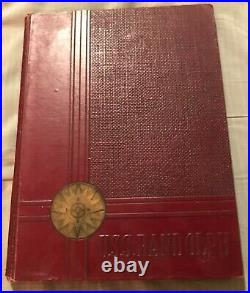
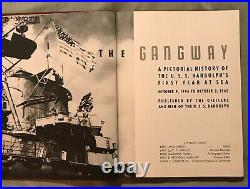
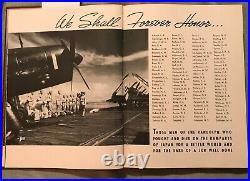
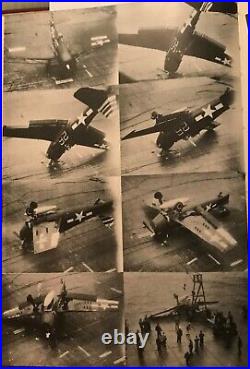
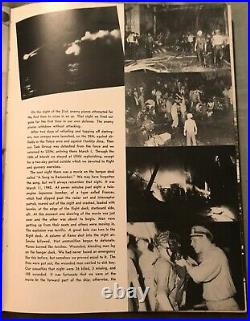
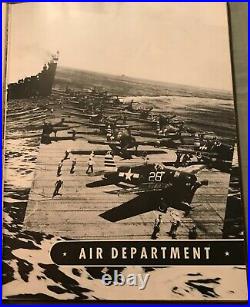
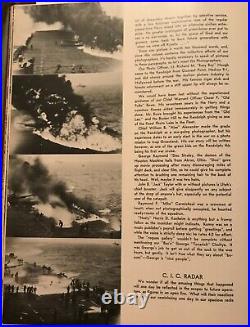
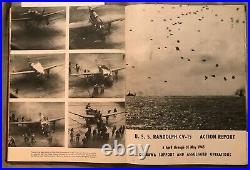
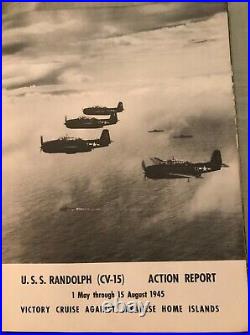

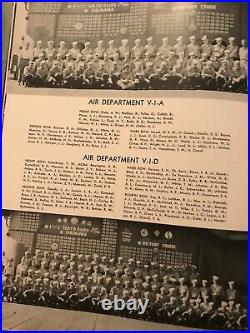


Pictorial History Aircraft Carrier. The Gangway: A Pictorial History of the U. Randolphs First Year at Sea October 9, 1944 to October 9, 1945. Published by the Officers and Men of the U. Randolph, Lt Jack Herod, editor. Kingkraft/Campus Books: Philadelphia, Pennsylvania (1946). Large hardcover in embossed decorative boards with a compass device, unpaginated approximately 156 pages. Illustrated with maps and black & white photographs throughout. A period piece published the year after the Second World War ended. Very good condition, some rubbing, edge and corner wear, all very minor. A nice clean copy. USS Randolph (CV/CVA/CVS-15) was one of 24 Essex-class aircraft carriers built during World War II for the United States Navy. Randolph was commissioned in October 1944 and served in several campaigns in the Pacific Theater of Operations, earning three battle stars. Decommissioned shortly after the end of the war, she was modernized and recommissioned in the early 1950s as an attack carrier (CVA), and then eventually became an antisubmarine carrier (CVS). In her second career she operated exclusively in the Atlantic, Mediterranean, and Caribbean. USS Randolph in World War II. Following a shakedown cruise off Trinidad, Randolph got underway for the Panama Canal and the Pacific. On 31 December, she reached San Francisco where Air Group 87 was detached, and Air Group 12 reported on board for four months duty. On 20 January 1945, Randolph departed San Francisco for Ulithi, from which she sortied on 10 February with Task Force 58. She launched attacks on 1617 February against Tokyo airfields and the Tachikawa engine plant. The following day, she made a strike on the island of Chichi Jima. On 20 February, she launched three aerial sweeps in support of ground forces invading Iwo Jima and two against Haha Jima. During the next four days, further strikes hit Iwo Jima and combat air patrols were flown almost continuously. Riding at anchor at Ulithi on 11 March, a Yokosuka P1Y1 “Frances” kamikaze hit Randolph on the starboard side aft just below the flight deck, killing 27 men and wounding 105. At this point Lt. What ensued became the most extensive repair-at-sea ever performed by the US Navy. Humphrey’s first act was to move number six (forward) arresting-gear catapult engine aft to replace the destroyed number one engine. Some 29 tons of structural steel, including I-beams salvaged from a Japanese sugar mill on newly liberated Saipan, were utilized. An additional 7,500 board feet of lumber was required to repair Randolphs flight deck. In the words of Cmdr. Charles Minter, assistant air officer on board Randolph, That decision to remain in the forward area [for repairs] allowed us to complete the war in an operational status. I doubt anyone could estimate how long we would have been in the yard had we gone back to the States, and the loss of the Randolph at that particular time would have been crucial. Samuel Humphreys saved the day. Working twenty-four hours a day at sea off Ulithi, Randolphs repairs, initiated immediately after the fires from the 11 March kamikaze attack were extinguished, were completed by 1 April, the launch date of the Okinawa invasion. Randolph joined Task Force 58 on 7 April. Combat air patrols (CAP) were flown daily until 14 April, when strikes were sent against Okinawa, Ie Shima, and Kakeroma Island. The following day, an air support mission of fighters, bombers, and torpedo planes hit Okinawa and a fighter sweep struck an airfield in southern Kysh. Under daily air attack from 17 April on, Randolph continued to send her aircraft on CAP and support missions throughout the month. In May, planes from the carrier hit the Ryukyu Islands and southern Japan, Kikai (Amami Islands) naval base and airfields, and Kysh airfields. Becoming the flagship of TF 58 on 15 May, Randolph continued her support of the occupation of Okinawa until 29 May, when she retired via Guam to the Philippines. On her next war cruise, as a part of Admiral Halsey’s 3rd Fleet, Randolph made a series of strikes up and down the Japanese home islands. In this attack, two of the important Honsh-Hokkaid train ferries were sunk and three were damaged. Attacks on the Japanese home islands continued for the next few days, and on 18 July, the Japanese battleship Nagato lying camouflaged alongside a pier at the Yokosuka Naval Base was bombed. Randolph’s pilots estimated that from 10 to 25 July they had destroyed 25 to 30 ships, ranging in size from small luggers to a 6000-ton freighter, and had damaged 35 to 40 others. Randolph’s strikes continued right up to the morning of the 15 August surrender, when her planes hit Kisarazu Airfield and surrounding installations. Following the end of the war, Randolph headed home. Transiting the Panama Canal in late September, she arrived at Naval Station Norfolk on 15 October, where she was rigged for “Magic Carpet” service. Before the end of the year, she completed two trips to the Mediterranean area to return American servicemen from Europe. The item “Gangway Pictorial History Aircraft Carrier USS Randolph in World War II 1944-45″ is in sale since Monday, October 4, 2021. This item is in the category “Collectibles\Militaria\WW II (1939-45)\Original Period Items\United States\Other US WWII Original Items”. The seller is “weasle_4u” and is located in Espanola, New Mexico. This item can be shipped to United States.
- Region of Origin: United States
- Modified Item: No
- Country/Region of Manufacture: United States
- Theme: Militaria
- Original/Reproduction: Original
- Conflict: WW II (1939-45)
